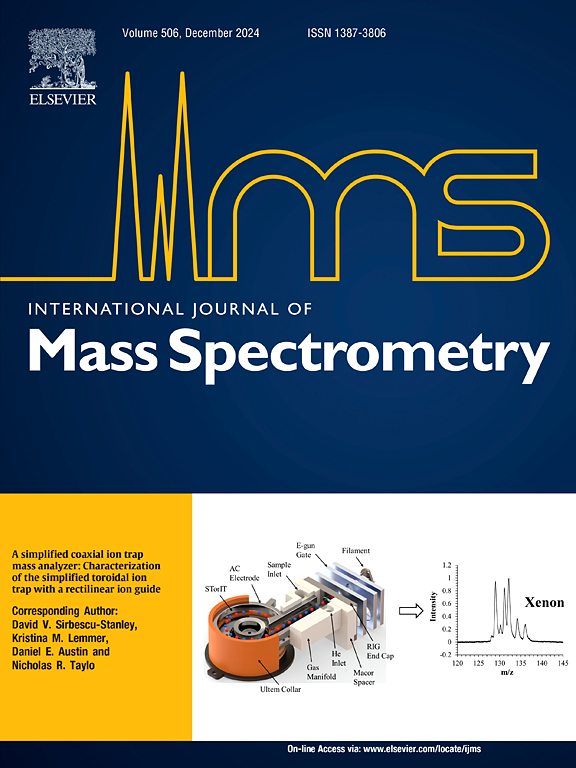Extraction anode lens effects in gas phase peptide cation-electron reactions
IF 1.7
3区 化学
Q3 PHYSICS, ATOMIC, MOLECULAR & CHEMICAL
引用次数: 0
Abstract
Gas phase cation-electron reactions, from electron capture dissociation (ECD; <1 eV electrons) to electron ionization dissociation (>∼26 eV electrons), are highly beneficial for biomolecular structural characterization. These techniques offer high sequence coverage, labile posttranslational modification retention, and sidechain loss fragments which can differentiate isomeric residues. For optimum performance, careful tuning of electron energy, flux, and irradiation time is required to reach efficiency at a particular energy regime. The cathode bias voltage (CBV) is the primary determinant of electron energy, while several parameters including CBV, extraction anode lens voltage (LV), and cathode heating current determine electron flux. We present an in-depth examination of how the interplay of these parameters at variable irradiation times results in differing peptide cation-electron reaction regimes. A particularly interesting finding was the prominent high energy fragmentation pathways observed at low (∼−1.0 V) CBV and high (>50 V) LV, as compared with conventional (∼5 V) LV for peptide ECD. Specifically, high LV resulted in tandem ionization, observed for both singly- and doubly protonated peptides, alongside increased sequence coverage for both charge states from complex spectra containing a multitude of a/b/c′/d/w/x/y′/z•-type terminal fragments as well as internal fragments and a large number of neutral losses. Electron flux and energy measurements as well as electron irradiation at constant flux showed that an increased number of higher energy electrons are present at high vs. low LV, i.e., the observed “lens effect” is likely due to the presence of high energy electrons under such conditions. This extraction anode lens effect may explain previous observations of unexpected internal fragments from ECD.

气相多肽阳离子-电子反应中的萃取阳极透镜效应
气相阳离子-电子反应,来自电子俘获解离(ECD);<;1 eV电子)到电子电离解离(>; ~ 26 eV电子),对生物分子结构表征非常有利。这些技术提供了高序列覆盖率,不稳定的翻译后修饰保留,以及可以区分异构体残基的侧链损失片段。为了获得最佳性能,需要仔细调整电子能量、通量和照射时间,以达到特定能量状态下的效率。阴极偏置电压(CBV)是电子能量的主要决定因素,而CBV、萃取阳极透镜电压(LV)和阴极加热电流等参数决定了电子通量。我们提出了一个深入的研究如何这些参数的相互作用,在不同的辐照时间导致不同的肽阳离子-电子反应制度。一个特别有趣的发现是,与肽ECD的常规(~ 5 V)低压相比,在低(~ 1.0 V) CBV和高(>50 V)低压下观察到明显的高能碎片化途径。具体来说,高低压导致串联电离,在单质子化和双质子化肽中都观察到,同时增加了包含大量a/b/c ' /d/w/x/y ' /z•型末端片段以及内部片段和大量中性损失的复杂光谱中两种电荷态的序列覆盖率。电子通量和能量测量以及恒定通量下的电子辐照表明,在高低压比低低压下存在更多的高能电子,即观察到的“透镜效应”可能是由于在这种条件下存在高能电子。这种提取阳极透镜效应可以解释以前从ECD中观察到的意想不到的内部碎片。
本文章由计算机程序翻译,如有差异,请以英文原文为准。
求助全文
约1分钟内获得全文
求助全文
来源期刊
CiteScore
3.60
自引率
5.60%
发文量
145
审稿时长
71 days
期刊介绍:
The journal invites papers that advance the field of mass spectrometry by exploring fundamental aspects of ion processes using both the experimental and theoretical approaches, developing new instrumentation and experimental strategies for chemical analysis using mass spectrometry, developing new computational strategies for data interpretation and integration, reporting new applications of mass spectrometry and hyphenated techniques in biology, chemistry, geology, and physics.
Papers, in which standard mass spectrometry techniques are used for analysis will not be considered.
IJMS publishes full-length articles, short communications, reviews, and feature articles including young scientist features.

 求助内容:
求助内容: 应助结果提醒方式:
应助结果提醒方式:


